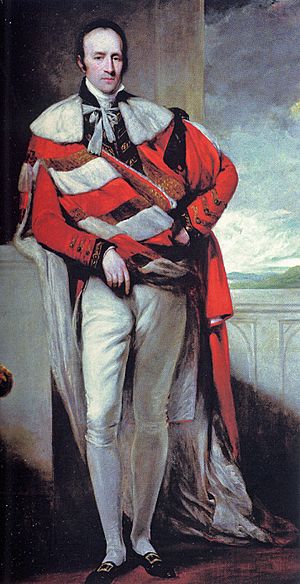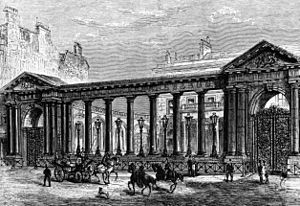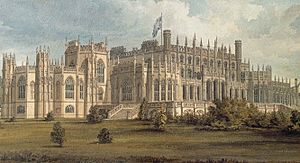Robert Grosvenor, 1st Marquess of Westminster facts for kids
Quick facts for kids
The Most Honourable
The Marquess of Westminster
|
|
|---|---|

The Marquess of Westminster by John Jackson
|
|
| Personal details | |
| Born | 22 March 1767 St George Hanover Square, London |
| Died | 17 February 1845 (aged 77) Eaton Hall, Cheshire, England |
| Resting place | St Mary's Church, Eccleston, Cheshire |
| Nationality | English |
| Political party | Tory, then Whig |
| Spouse | Eleanor Egerton |
| Children |
|
| Parents |
|
| Residences | Eaton Hall, Grosvenor House |
| Alma mater | |
Robert Grosvenor, 1st Marquess of Westminster (born March 22, 1767 – died February 17, 1845) was an important English nobleman. He was the son of the 1st Earl Grosvenor and took over his father's title as the 2nd Earl Grosvenor in 1802. Later, in 1831, he was given the even higher title of Marquess of Westminster.
Robert Grosvenor was also a Member of Parliament (MP), which means he helped make laws for the country. He is an ancestor of the current Dukes of Westminster. He worked hard to improve his family's properties, especially their land in London. He also rebuilt their large country home, Eaton Hall, and made its gardens beautiful again. He built a new home in London called Grosvenor House. Robert Grosvenor also loved art and horses, continuing his family's passion for collecting artworks and breeding racehorses.
Contents
About Robert's Early Life
Robert Grosvenor was born in London on March 22, 1767. He was the third son of Richard Grosvenor, 1st Earl Grosvenor and Henrietta, Lady Grosvenor. He was their only child who lived to be an adult. When he was young, he was known as Viscount Belgrave.
He went to some famous schools, including Westminster School and Harrow School. He then studied at Trinity College, Cambridge, where he earned a Master of Arts degree in 1786. Besides his school studies, he had a private teacher named William Gifford. Gifford traveled with Robert on his "Grand Tour" between 1786 and 1788. A Grand Tour was a long trip around Europe that young noblemen often took to learn about art, culture, and history. Gifford said Robert was a "most amiable" (very kind) and "accomplished" (skilled) student.
On April 28, 1794, Robert Grosvenor married Eleanor. She was the only child of Sir Thomas Egerton, who later became the 1st Earl Wilton. Robert and Eleanor had four children:
- Richard, born in 1795, who took over his father's titles.
- Thomas, born in 1799, who became the 2nd Earl of Wilton.
- Robert, born in 1801, who later became the 1st Baron Ebury.
- Amelia, a daughter who sadly passed away when she was a teenager.
Robert's Role in Politics
Robert Grosvenor became a Member of Parliament (MP) for East Looe in 1788. An MP is a person elected to represent an area in the House of Commons of Great Britain, where laws are debated and made. During this time, he was also appointed a Lord of the Admiralty, which meant he helped manage the British Navy.
His first speech in Parliament included a quote from an ancient Greek speaker named Demosthenes. This led a writer named Peter Pindar to jokingly call him "the lord of Greek." In 1790, he became an MP for Chester and served there until 1802. He also helped oversee the Board of Control, which managed affairs in India.
Robert Grosvenor also showed his patriotism by forming a group of volunteers from Westminster to fight against France. In 1798, he was made their major-commandant. When his father died in 1802, Robert became the 2nd Earl Grosvenor. He was also the Mayor of Chester in 1807–08 and helped build the Northgate in the city. He served as the Lord Lieutenant of Flintshire from 1798 to 1845, which was a royal representative role.
When Robert first entered Parliament, he followed his family's tradition of being a Tory. Tories were a political group that supported the king and traditional ways. He supported William Pitt the Younger, a famous Prime Minister. However, after Pitt died in 1806, Robert changed his mind and became a Whig. Whigs were another political group who often supported more reforms and changes.
As a Whig, he supported important causes like:
- Helping the victims of the Peterloo massacre, where people protesting for rights were attacked.
- Catholic Emancipation, which meant giving Roman Catholics more rights.
- Ending the Corn Laws, which were laws that made bread expensive.
- Voting for the Reform Bill, which changed how people voted and gave more people the right to vote.
Robert Grosvenor was a man who stood up for what he believed in. He supported Queen Caroline, who was treated unfairly by her husband, King George IV. It's even said that he once threw a Bible or Prayer Book at the King! He also refused to let the Duke of Wellington use the Chester town hall because he disagreed with him. Despite this, his relationship with the King improved, and in 1831, he was given the title Marquess of Westminster. He also took part in the coronation of Queen Victoria in 1837 and became a Knight of the Garter in 1841, which is a very high honor.
Developing the Family Estates
After Robert Grosvenor inherited the Eaton estate, he quickly started to rebuild the country house at Eaton Hall in Cheshire. He also worked on developing the family's land in London, creating the famous areas known today as Belgravia and Pimlico. The old Eaton Hall was quite old-fashioned and needed a lot of work.
He hired an architect named William Porden to design the new house. The plan was for the new house to cost about £10,000 and take two years to build. But it ended up taking almost ten years and costing over £100,000! The new Eaton Hall was built around the old house and featured many Gothic style elements like turrets, pinnacles, arched windows, and towers. Four new sections were added to the house. When the future Queen Victoria visited in 1832, at age 13, she wrote in her diary that the house was "magnificent." However, some people thought it was too showy or had "bad taste."
To improve the gardens and grounds, Robert Grosvenor hired John Webb. New walls were built on the east side of the house. Belgrave Avenue, the long road leading to the house, was made flat and drained. Over 130,000 trees were planted along it. The paths were made wide enough for carriages. A winding lake was also created near the River Dee. Later, in the 1820s, formal garden beds became popular, and William Andrews Nesfield was hired to design beautiful, organized gardens with terraces, balustrades, and flower beds.

For the London estate, Robert Grosvenor wanted to create a stylish new neighborhood near Buckingham House (which later became Buckingham Palace). He hired Thomas Cundy as the architect and Thomas Cubitt as the builder. This huge building project made the Grosvenor family one of the richest families in Britain. He also bought more land in Cheshire and other parts of England.
The family's old London home was in Millbank. But in 1806, Robert bought a house in Upper Grosvenor Street and made it much bigger. This house became known as Grosvenor House. He added an art gallery to one side of the house in 1827. In 1843, he built a grand new entrance with large gateways, creating a fancy courtyard like those seen in Paris.
Robert's Hobbies and Interests
Robert Grosvenor continued his family's love for art and horse racing. He added many new pieces to their art collection. He bought four paintings by the famous artist Rubens for £10,000. He also bought Gainsborough's famous painting, The Blue Boy, for £100.
To improve his horse racing, he made the Eaton Stud much larger. A "stud" is a place where horses are bred. The best horse from his stud during his time was named Touchstone. This amazing horse won 16 out of the 21 races he entered, including important ones like the St Leger and the Ascot Gold Cup. After Touchstone retired from racing, he became a father to 323 winning horses, who together won over 700 races!
Robert's Passing

Robert Grosvenor passed away at Eaton Hall on February 17, 1845. He was buried in the family burial place at St Mary's Church, Eccleston. His oldest son, Richard Grosvenor, 2nd Marquess of Westminster, took over his titles and responsibilities.
In 1998, a statue of Robert Grosvenor was put up in Belgrave Square, London. On the statue, there is a quote by the writer Ruskin that says: "When we build let us think we build for ever." This quote reminds us of Robert Grosvenor's lasting impact through the buildings and estates he developed.



